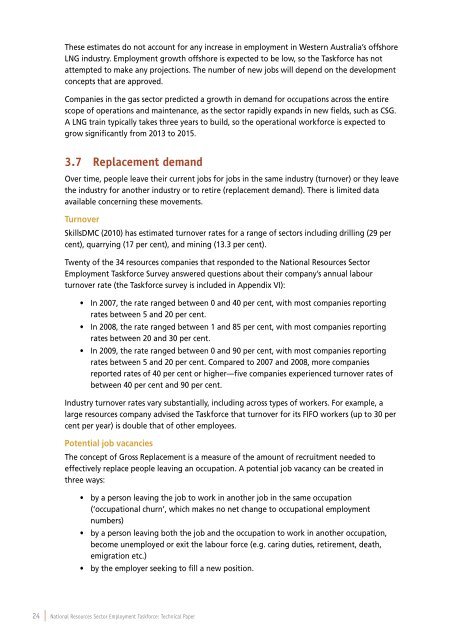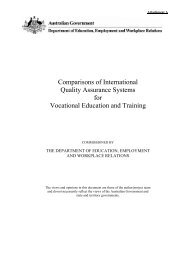National Resources Sector Employment Taskforce Technical Paper
National Resources Sector Employment Taskforce Technical Paper
National Resources Sector Employment Taskforce Technical Paper
You also want an ePaper? Increase the reach of your titles
YUMPU automatically turns print PDFs into web optimized ePapers that Google loves.
These estimates do not account for any increase in employment in Western Australia’s offshore<br />
LNG industry. <strong>Employment</strong> growth offshore is expected to be low, so the <strong>Taskforce</strong> has not<br />
attempted to make any projections. The number of new jobs will depend on the development<br />
concepts that are approved.<br />
Companies in the gas sector predicted a growth in demand for occupations across the entire<br />
scope of operations and maintenance, as the sector rapidly expands in new fields, such as CSG.<br />
A LNG train typically takes three years to build, so the operational workforce is expected to<br />
grow significantly from 2013 to 2015.<br />
3.7 Replacement demand<br />
Over time, people leave their current jobs for jobs in the same industry (turnover) or they leave<br />
the industry for another industry or to retire (replacement demand). There is limited data<br />
available concerning these movements.<br />
Turnover<br />
SkillsDMC (2010) has estimated turnover rates for a range of sectors including drilling (29 per<br />
cent), quarrying (17 per cent), and mining (13.3 per cent).<br />
Twenty of the 34 resources companies that responded to the <strong>National</strong> <strong>Resources</strong> <strong>Sector</strong><br />
<strong>Employment</strong> <strong>Taskforce</strong> Survey answered questions about their company’s annual labour<br />
turnover rate (the <strong>Taskforce</strong> survey is included in Appendix VI):<br />
• In 2007, the rate ranged between 0 and 40 per cent, with most companies reporting<br />
rates between 5 and 20 per cent.<br />
• In 2008, the rate ranged between 1 and 85 per cent, with most companies reporting<br />
rates between 20 and 30 per cent.<br />
• In 2009, the rate ranged between 0 and 90 per cent, with most companies reporting<br />
rates between 5 and 20 per cent. Compared to 2007 and 2008, more companies<br />
reported rates of 40 per cent or higher—five companies experienced turnover rates of<br />
between 40 per cent and 90 per cent.<br />
Industry turnover rates vary substantially, including across types of workers. For example, a<br />
large resources company advised the <strong>Taskforce</strong> that turnover for its FIFO workers (up to 30 per<br />
cent per year) is double that of other employees.<br />
Potential job vacancies<br />
The concept of Gross Replacement is a measure of the amount of recruitment needed to<br />
effectively replace people leaving an occupation. A potential job vacancy can be created in<br />
three ways:<br />
• by a person leaving the job to work in another job in the same occupation<br />
(‘occupational churn’, which makes no net change to occupational employment<br />
numbers)<br />
• by a person leaving both the job and the occupation to work in another occupation,<br />
become unemployed or exit the labour force (e.g. caring duties, retirement, death,<br />
emigration etc.)<br />
• by the employer seeking to fill a new position.<br />
24 | <strong>National</strong> <strong>Resources</strong> <strong>Sector</strong> <strong>Employment</strong> <strong>Taskforce</strong>: <strong>Technical</strong> <strong>Paper</strong>
















